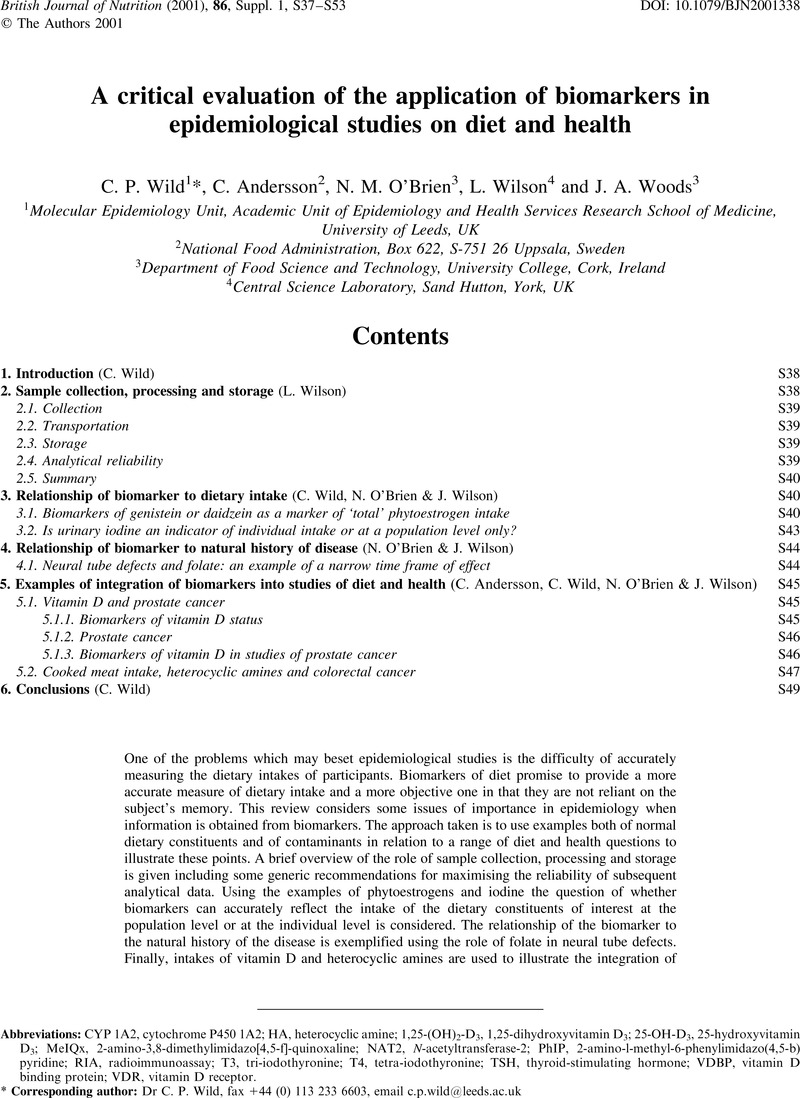Crossref Citations
This article has been cited by the following publications. This list is generated based on data provided by Crossref.
Wilson, Samuel
2002.
Biomarkers of Environmentally Associated Disease.
Knasmüller, S
and
Verhagen, H
2002.
Impact of dietary factors on cancer causes and DNA integrity: new trends and aspects.
Food and Chemical Toxicology,
Vol. 40,
Issue. 8,
p.
1047.
Ames, Bruce N.
and
Wakimoto, Patricia
2002.
Are vitamin and mineral deficiencies a major cancer risk?.
Nature Reviews Cancer,
Vol. 2,
Issue. 9,
p.
694.
Hall, Kristyn D.
Stephen, Alison M.
Reeder, Bruce A.
Muhajarine, Nazeem
and
Lasiuk, Gail
2003.
Diet, Obesity and Educationin Three Age Groups of Saskatchewan Women.
Canadian Journal of Dietetic Practice and Research,
Vol. 64,
Issue. 4,
p.
181.
Lorenzetti, S.
and
Branca, F.
2003.
Phytochemical Functional Foods.
p.
189.
Pollard, J
Wild, C P
White, K L M
Greenwood, D C
Cade, J E
and
Kirk, S F L
2003.
Comparison of plasma biomarkers with dietary assessment methods for fruit and vegetable intake.
European Journal of Clinical Nutrition,
Vol. 57,
Issue. 8,
p.
988.
Ritchie, Margaret R.
Morton, Michael S.
Deighton, Nigel
Blake, Alison
and
Cummings, John H.
2004.
Plasma and urinary phyto-oestrogens as biomarkers of intake: validation by duplicate diet analysis.
British Journal of Nutrition,
Vol. 91,
Issue. 3,
p.
447.
Dahl, Lisbeth
Johansson, Lars
Julshamn, Kåre
and
Meltzer, Helle Margrete
2004.
The iodine content of Norwegian foods and diets.
Public Health Nutrition,
Vol. 7,
Issue. 4,
p.
569.
Clarke, D. B.
and
Lloyd, A. S.
2004.
Dietary exposure estimates of isoflavones from the 1998 UK Total Diet Study.
Food Additives & Contaminants,
Vol. 21,
Issue. 4,
p.
305.
Maruvada, Padma
and
Srivastava, Sudhir
2004.
Biomarkers for Cancer Diagnosis: Implications for Nutritional Research.
The Journal of Nutrition,
Vol. 134,
Issue. 6,
p.
1640S.
Weinstein, Stephanie J.
Vogt, Tara M.
and
Gerrior, Shirley A.
2004.
Healthy eating index scores are associated with blood nutrient concentrations in the third National Health and Nutrition Examination Survey.
Journal of the American Dietetic Association,
Vol. 104,
Issue. 4,
p.
576.
Verhagen, Hans
Coolen, Stefan
Duchateau, Guus
Hamer, Mark
Kyle, Janet
and
Rechner, Andreas
2004.
Assessment of the efficacy of functional food ingredients—introducing the concept “kinetics of biomarkers”.
Mutation Research/Fundamental and Molecular Mechanisms of Mutagenesis,
Vol. 551,
Issue. 1-2,
p.
65.
Pomerleau, Joceline
Lock, Karen
McKee, Martin
and
Altmann, Dan R.
2004.
The Challenge of Measuring Global Fruit and Vegetable Intake.
The Journal of Nutrition,
Vol. 134,
Issue. 5,
p.
1175.
Karahalil, Bensu
2005.
Phytoestrogens In Functional Foods.
Zaroukian, S.
Pineault, R.
Gandini, S.
Lacroix, A.
and
Ghadirian, P.
2005.
Correlation between nutritional biomarkers and breast cancer: a case-control study.
The Breast,
Vol. 14,
Issue. 3,
p.
209.
2006.
Nutrition and the Eye.
p.
43.
Heng, Christine K.
Badner, Victor M.
and
Freeman, Katherine D.
2006.
Relationship of Cigarette Smoking to Dental Caries in a Population of Female Inmates.
Journal of Correctional Health Care,
Vol. 12,
Issue. 3,
p.
164.
Åman, Per
Ross, Alastair B.
Landberg, Rikard
and
Kamal‐Eldin, Afaf
2007.
Whole Grains and Health.
p.
209.
Guntupalli, J. Naga Raju
Padala, Sarita
Gummuluri, A.V. Ramana Murty
Muktineni, Ravi Kumar
Byreddy, Seetharami Reddy
Sreerama, Lakshminarayana
Kedarisetti, Prema Chand
Angalakuduru, Durga Prasad
Satti, Bhuloka Reddy
Venkatathri, Vijayan
Pullela, V.B. Rama Lakshmi
and
Gavarasana, Satyanarayana
2007.
Trace elemental analysis of normal, benign hypertrophic and cancerous tissues of the prostate gland using the particle-induced X-ray emission technique.
European Journal of Cancer Prevention,
Vol. 16,
Issue. 2,
p.
108.
Shurubor, Yevgeniya I
Matson, Wayne R
Willett, Walter C
Hankinson, Susan E
and
Kristal, Bruce S
2007.
Biological variability dominates and influences analytical variance in HPLC-ECD studies of the human plasma metabolome.
BMC Clinical Pathology,
Vol. 7,
Issue. 1,



